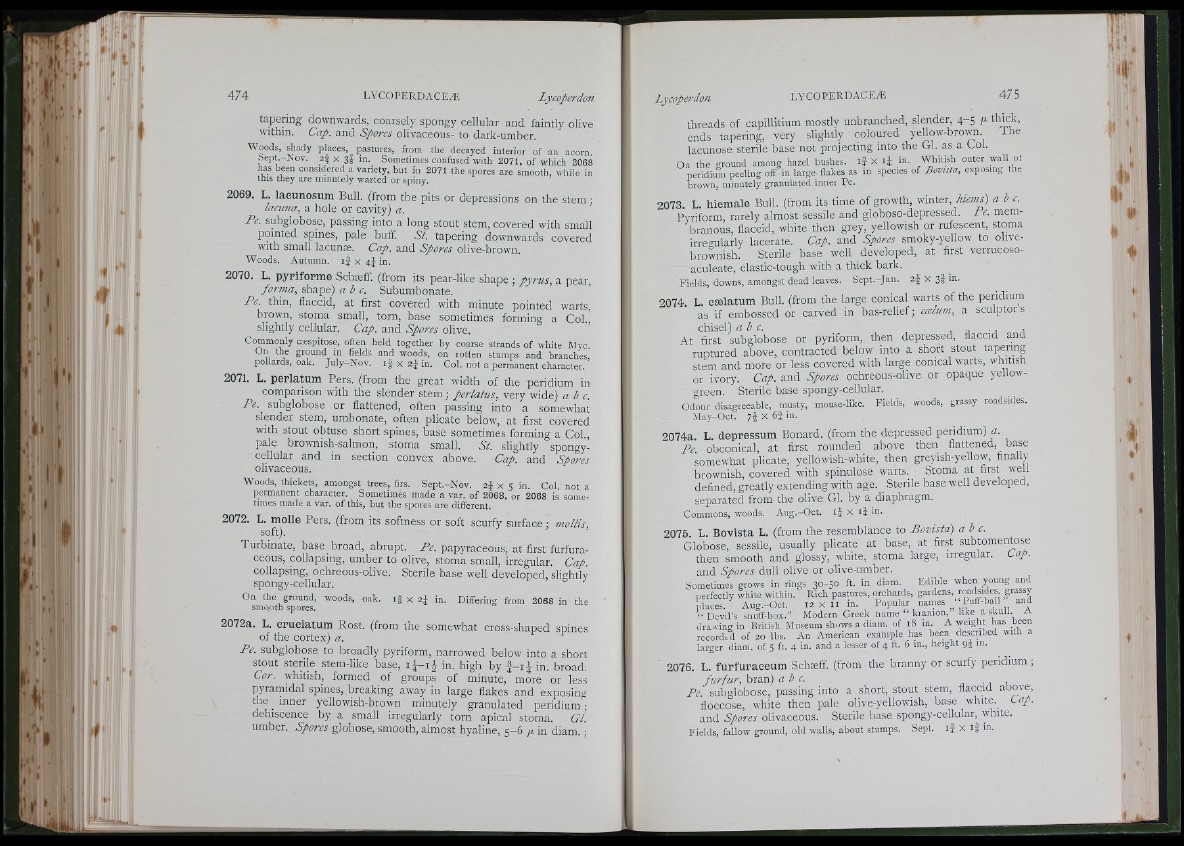
W !
■M
4 7 4
tapering downwards, coarsely spongy cellular and faintly olive
within. Cap. and Spores olivaceous- to dark-umber.
Woods, shady places, pastures, from the decayed interior of an acorn.
bept.-Nov. 2f X 3® in. Sometimes confused with 2 0 7 1 , of which 2068
has been considered a variety, but in 2071 the spores are smooth, while in
this they are minutely warted or spiny.
2069. L. laeunosum Bull, (from the pits or depressions on the stem :
lacuna, a hole or cavity) a.
Pc. subglobose, passing into a long stout stem, covered with small
pointed spines, pale buff. A/, tapering downwards covered
with small lacunæ. Cap. and Spores olive-brown.
Woods. Autumn, i f x 4® in.
2070. L. pypiforme Schæff. (from its pear-like shape ; pyrus, a pear,
forma, shape) abc . Subumbonate.
Pe. thin, flaccid, at first covered with minute pointed warts,
brown, stoma small, torn, base sometimes forming a Col.
slightly cellular. Cap. and Spores olive.
Commonly cæspitose, often held together by coarse strands of white Myc
On the ground in fields and woods, on rotten stumps and branches,
pollards, oak. July-Nov. i f X 2^ in. Col. not a permanent character.
2071. L. perlatum Pers. (from the great width of the peridium in
comparison with the slender stem ; perlatus, very wide) abc.
Pe. subglobose or flattened, often passing into a somewhat
slender stem, umbonate, often plicate below, at first covered
with stout obtuse short spines, base sometimes forming a Col,
pale brownish-salmon, stoma small. St. shghtly spongy-
cellular and in section convex above. Cap. and Spores
olivaceous.
Woods, thickets, amongst trees, firs. Sept.-Nov. 2® x 5 in. Col. not a
permanent character. Sometimes made a var. of 2 0 6 8 , or 206 8 is sometimes
made a var. of this, but the spores are different.
2072. L. molle Pers. (from its softness or soft scurfy surface ; mollis,
soft).
Turbinate, base broad, abrupt. Pe. papyraceous, at first furfuraceous,
collapsing, umber to olive, stoma smah, irregular. Cap.
collapsing, ochreous-olive. Sterile base well developed, slightly
spongy-cellular.
On the ground, woods, oak. 1# X 2® in. Differing from 2 0 6 8 in the
smooth spores.
2072a. L. erueiatum Rost, (from the somewhat cross-shaped spines
of the cortex) a.
Pe. subglobose to broadly pyriform, narrowed below into a short
stout sterile stem-like base, in. high by f - i j in. broad.
Cor. whitish, formed of groups of minute, more or less
pyramidal spines, breaking away in large flakes and exposing
the inner yellowish-brown minutely granulated peridium'”;
dehiscence by a small irregularly torn apical stoma. Gl.
umber. Spores globose, smooth, almost hyaline, 5-6 ¡t. in diam. ■
threads of capillitium mostly unbranched, slender, 4-5 thick,
ends tapering, very slightly coloured yellow-brown The
lacunose sterile base not projecting into the Gl. as a Col.
Ou the ground among hazel bushes. i | X i® in. Whitish outer wall ot
peridium peeling off in large- flakes as in species of Bomsia, exposing the
brown, minutely granulated inner Pe.
2073. L. hiemale Bull, (from its time of growth, winter, Memi) abc.
Pvriform, rarely almost sessile and globoso-depressed. Pe. membranous,
flaccid, white then grey, yellowish or rufescent, stoma
irregularly lacerate. Cap. and Spores smoky-yellow to olive-
broLish. Sterile base well developed, at first verrucoso-
aculeate, elastic-tough with a thick bark.
Fields, downs, amongst dead leaves. Sept.-Jan. 2® X 3I in.
2074. L. eælatum Bull, (from the large conical warts of the peridium
as if embossed or carved in bas-relief; cælum, a sculptors
chisel) abc . , a -, a
At first subglobose or pyriform, then depressed, flaccid and
ruptured above, contracted below into a short stout tapering
stem and more or less covered with large conical warts, whitish
or ivory. Cap. and Spores ochreous-olive or opaque yellow-
green. Sterile base spongy-cellular.
Odour disagreeable, musty, mouse-like. Fields, woods, grassy roadsides.
May-Oct. 7® X 6 f in.
2074a. L. depressum Bonard, (from the depressed peridium) «.
Pc obconical, at first rounded above then flattened, base
somewhat plicate, yellowish-white, then greyish-yellow, finally
brownish, covered with spinulose warts. Stoma at first well
defined, greatly extending with age. Sterile base well developed,
separated from the olive Gl. by a diaphragm.
Commons, woods. Aug.-Oct. i® X i® in.
2075. L. Bovista L. (from the resemblance to Bovista) abc.
Globose, sessile, usually plicate at base, at first subtomentose
then smooth and glossy, white, stoma large, irregular. Lap.
and Spores dull olive or olive-umber.
Sometimes grows in rings 30-50 ft. in diam. Edible when young and
perfectly white within. Rich pastures, orchards, gardens, roadsides s,rassy
places. Aug.-Oct. 12 x I I in. P o p u l a r nanms ^ Pufl-ball and
“ Devil’s snuff-box.” Modern Greek name* kranion, like a skull. A
drawing in British Museum shows a diam. of 18 in. A weight has been
recorded of 20 lbs. An American example has been descnbed with a
larger diam. of 5 ft. 4 in. and a lesser of 4 ft. 6 in., height 9® in.
2076. L. furfuraeeum Schæff. (from the branny or scurfy peridium ;
furfur, bran) abc. „ • j u
Pe. subglobose, passing into a short, stout stem, flaccid above,
floccose, white then pale olive-yellowish, base white.^ Lap.
and Spores olivaceous. Sterile base spongy-cellular, white.
Fields, fallow ground, old walls, about stumps. Sept. i | X i | m.
i 1
il*